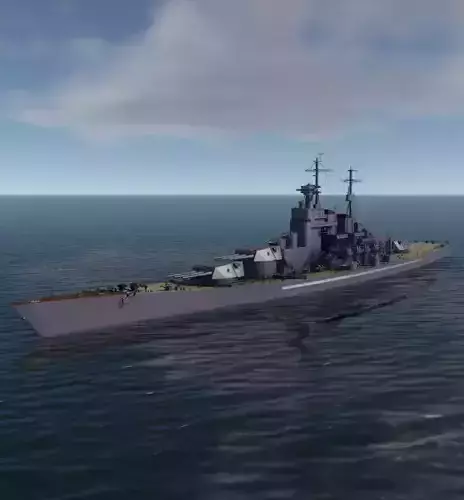1/6
A battleship design developed after the end of World War II (Project 24). The ship constituted a further development of the Sovetsky Soyuz class, intended to counter US battleships of the Iowa and Montana classes.
In 1939 several faults were found with the design of the Sovetsky Soyuz-class. Although some Project 23 variants corrected these faults, in December of 1940 it was decided to instead develop a completely new project, taking into account desired characteristics and the fact that slipways would become available only in 1943. Thus, Project 24 was born.
In May 1941, preliminary Operational-Tactical Requirements (OTZ) were outlined for the newly-designated project. While the main battery and secondary battery were to remain the same as the Sovetsky Soyuz-class, the outline sought improvements to the battleship’s AA, armor scheme, speed, range and torpedo protection. Work on Project 24 was assigned to TsKB-4, which had worked on the Sovetsky Soyuz-class. However, with Germany’s invasion of the Soviet Union in June 1941, work on the project temporarily ceased until the bureau was evacuated to Moscow in August 1941, where work continued. Initial studies of Project 24 bore a strong resemblance to Project 23, though with refined individual aspects.
This design was likely an exploratory one, as it did not fully meet the requirements, particularly the speed. It most likely showed that Project 24 would have to significantly exceed the dimensions of Project 23 to fully meet the requirements. In July of 1944 the requirements were revised, combining the 150 mm and 100 mm guns into a dual-purpose 24-gun 130 mm battery. The light AA was replaced by 45 mm guns as well.
Throughout 1944 and 1945, the navy’s Scientific-Technical Committee (NTK) and the Naval Academy carried out numerous studies on the battleship. These designs varied in size (from 75,000 to upwards of 130,000 tons), armament (12 406 mm to 9 457 mm guns). These designs were significantly larger than those of TsKB-4, due to information about the American Montana-class. Although the class was canceled in 1943, the Soviet Union expected construction on battleships by Western nations to resume. Indeed, several Western nations immediately following World War II continued to work on their battleships, such as the British Vanguard and French Jean Bart. However, it soon became apparent that there would be no new battleships laid down, and so the Soviet Union reverted its design efforts to countering the Iowa-class with 75,000 ton battleships. In August 1945 the navy drew up construction plans for a post-war navy that envisioned at least 10 75,000 ton battleships throughout the next decade. However, Navy Minister Nikolai Kuznetsov proposed a limit of four battleships. In a conference with Stalin on September 27 1945, the Soviet Union leader proposed a further reduction on the number of battleships — with one Project 23 battleships completed, and two more battleships laid down in the next few years. In November the planned battleships were delayed to 1955 for them to be laid down. Admiral Kuznetsov approved a revised OTZ on December 19, 1945, which had the following specifications:
REVIEWS & COMMENTS
accuracy, and usability.






